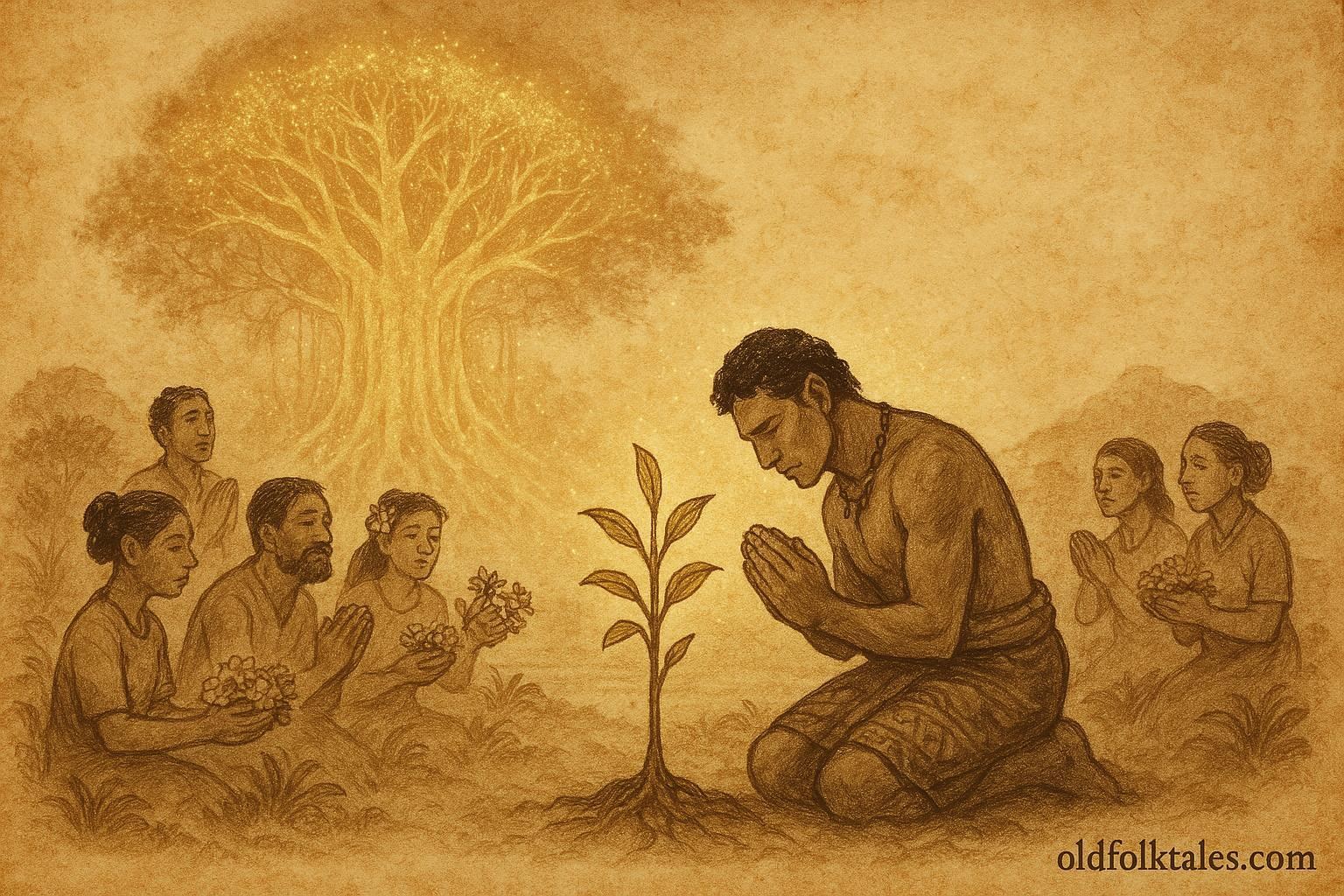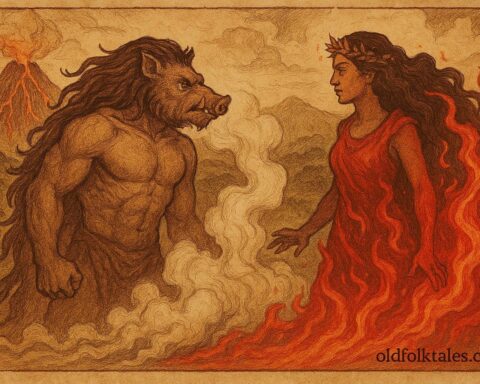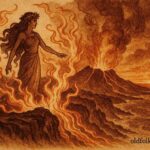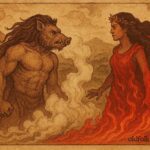In the green heart of an ancient Tongan island stood a great banyan tree. Its roots spread wide like a woven mat across the earth, and its branches reached so high that they seemed to brush the heavens. Generations of villagers had gathered in its shade, offered prayers beneath its trunk, and left gifts for the spirits who were said to dwell there.
To the people, the tree was sacred, a living bridge between earth and sky, between mortal and divine. But as time passed and the world grew restless with change, not everyone remembered the old reverence.
Sail through the legends of brave navigators, ocean spirits, and island gods
The Young Man’s Doubt
In one such village lived a young man named Tanoa, strong of arm and proud of spirit. Though he had been raised among elders who told stories of the gods, he laughed at their warnings.
“Old tales for old people,” he would say. “Trees are trees, and nothing more.”
Tanoa was ambitious. He dreamed of building a fine canoe to trade across the islands. But the timber he desired grew scarce near the shore. One morning, as he wandered inland with his axe, his gaze fell upon the mighty banyan.
The tree’s trunk was thick and straight, perfect for a canoe keel. The air beneath its canopy shimmered softly, filled with the whisper of leaves that seemed almost to breathe. Still, Tanoa saw only wood, not spirit.
He remembered the villagers’ words: “The spirits guard that tree. To harm it is to invite misfortune.” But Tanoa’s pride spoke louder. “If the gods wished to keep their tree, they should guard it themselves.”
So he raised his axe and struck the first blow.
The Felling of the Sacred Tree
The sound echoed like thunder through the valley. With each swing, the air grew heavier, as though the forest itself held its breath. Birds took flight, their cries sharp and warning.
At last, the great banyan groaned and fell, shaking the ground with its final breath. The young man, pleased with his strength, began cutting sections of the trunk to carry home. But as the sun set, he felt an unease creep over him.
A wind rose suddenly, swirling through the clearing. The branches of the fallen tree rustled though there was no life left in them. From the hollow trunk came a low sound, not quite wind, not quite voice.
Tanoa paused, heart pounding. “It’s only the breeze,” he muttered. Yet when he turned to leave, the air seemed to whisper his name:
“Tanoa…”
He fled down the path and did not look back.
The Spirit’s Visit
That night, the young man lay restless. His house was warm, yet he felt cold, as though shadow had entered with him. He dreamed, or thought he dreamed, of standing again before the fallen banyan.
In the dream, a figure rose from the broken trunk. It was neither man nor woman, but both, cloaked in leaves and light, its eyes deep as the roots of the earth. The spirit spoke with a voice that rustled like wind through branches:
“Why did you strike me down, Tanoa?”
The young man fell to his knees. “I meant no harm. I needed wood for my canoe.”
“You were warned,” said the spirit. “The tree was my dwelling. My roots stretched through your village, my shade cooled your fields. I gave you shelter, and you repaid me with an axe.”
Tanoa trembled. “Forgive me, great spirit. I did not believe the stories.”
“Then learn,” the spirit said. “The world breathes with life beyond what eyes can see. Every tree, every stone, every wave carries spirit. You have broken the balance. Now you must restore it.”
The spirit’s form began to fade, but its final words burned like fire:
“Plant what you have taken. Honor what you have harmed. Only then will peace return to your house.”
The Path to Atonement
At dawn, Tanoa woke drenched in sweat, his heart heavy with guilt. He gathered the villagers and told them what had happened. Some scoffed, others paled, but the elders nodded solemnly.
“The spirit of the banyan has spoken,” one said. “It is not too late, but the offering must be made in humility.”
Together, they returned to the clearing where the great tree had fallen. The stump stood silent, its roots bleeding sap like tears.
Following the elders’ guidance, Tanoa dug a pit beside it and planted a young banyan sapling, a child of the old tree, taken from a seed that had once dropped near its roots. He poured water over it and bowed low.
“Forgive my foolishness,” he whispered. “I see now that life flows through all things. I will guard this tree as I would my own kin.”
The villagers joined him, laying flowers and food at the base of the sapling. They chanted the old prayers, their voices weaving through the forest air.
As the last echo faded, a warm breeze stirred. The leaves of the new tree trembled, and from the stump of the old came a faint shimmer of light. The villagers felt it, a breath of peace returning to the land.
The Blessing of the Spirit
From that day forward, fortune smiled upon Tanoa’s household. His crops flourished, and fish filled his nets in abundance. Travelers who passed the new banyan said they felt calm beneath its shade, as though watched over by something kind and ancient.
Each year, on the day the tree had been felled, Tanoa gathered the village for a feast beneath its growing branches. He told the story of his folly and the mercy of the tree spirit, teaching that reverence for nature was not fear, but gratitude.
And when Tanoa grew old, his children continued the custom, ensuring that no one ever forgot the sacredness of the living world.
The banyan, nourished by care and prayer, grew vast once more, its roots entwined with memory, its leaves whispering softly to the wind. And those who listened closely swore they could hear a gentle voice among the rustling branches, saying:
“Balance restored. Peace endures.”
Moral of the Story
The Tongan legend of The Spirit of the Banyan Tree teaches that nature is sacred and alive. Disrespect toward the natural world brings imbalance, but humility and atonement restore harmony. When we honor the spirits of the earth, the earth blesses us in return.
Knowledge Check
- What did Tanoa do to anger the spirits?
He cut down a sacred banyan tree despite the villagers’ warnings. - Who appeared to Tanoa in his dream?
The spirit of the banyan tree, who demanded respect and repentance. - How did Tanoa seek forgiveness?
He replanted a banyan sapling and offered prayers to honor the spirit. - What happened after Tanoa made peace with the spirit?
His family and land were blessed with abundance and harmony. - What does the banyan tree symbolize in this story?
The interconnectedness of all life and the sacred power of nature. - What is the moral lesson of this folktale?
To live in respect and balance with the natural world and to atone for harm done to it.
Source: Adapted from “Tongan Folk Stories and Legends” collected by E. E. V. Collocott (1921).
Cultural Origin: Tongan (Polynesia, South Pacific)












